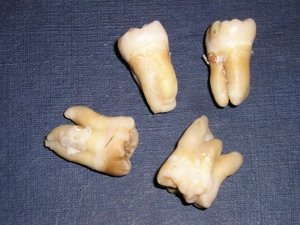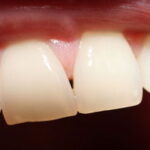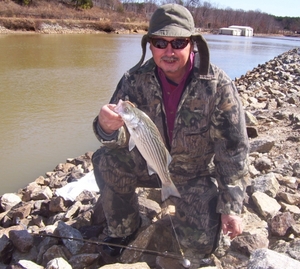About three months ago I had three wisdom teeth removed. Does this make me any less wise? Not to my knowledge. Perhaps it has made me even wiser, at least about the experience of having wisdom teeth removed. I decided to share this knowledge so that you could have a better idea of what to expect going into it. Although, knowing how bad it’s going to be probably won’t make it any better.
Cost
First of all, it isn’t cheap. If you have no dental insurance of any kind, expect to pay hefty out-of-pocket expenses. Sometimes medical insurance will pay for part of it, but mine would only pay for “bony impacted” teeth and the anesthesia associated with it. Plus I had to meet my high deductible first. In other words, they were no help to me.
I did, however, have Aflac dental insurance and they paid $520 of the bill, which was nice, but I had a six-month waiting period before they would cover it. Overall, it really depends on how your teeth are coming in, how many need removed, what kind of insurance you have and what oral surgeons charge in your area.
To give you a rough idea, though, it cost me $69 for the consultation appointment before the surgery for assessment, $245-$383 per tooth for extractions, $358 for sedation and $52 for therapeutic drug injections, coming to a grand total of $1,352.00. Ouch. This total does not include the initial dental appointment to get x-rays and an exam, so that my dentist could refer me to the oral surgeon, nor does it include the prescription antibiotics and pain pills after the surgery, which could easily add another $150 or more. Fortunately, at your initial consultation, you will be given a fairly accurate estimated cost so that you can prepare to pay for it (i.e. start selling unnecessary organs).
Preparing for Surgery
Also during your consultation, you will be told what to expect and what to do the day of the surgery. They should tell you to wear loose-fitting, comfortable clothes because you will be drugged-up for the rest of the day, sitting on the couch and drooling on yourself. If you plan to go to sleep for the surgery, you won’t be able to eat or drink anything for at least eight hours before they administer the drug…not even a sip of water when brushing your teeth. They might allow a sip for important medication, but they mean business. You will probably want to make your appointment as early in the day as possible or you will be starving before you go.
In addition, someone will need to drive you home and take care of you and they should know that they aren’t allowed to leave the waiting room to run errands. Apparently, this is to keep people from leaving and never coming back to pick up their semi-unconscious friend or relative. I was told that this has happened, believe it or not.
The Day of the Surgery
Typically, the whole experience will only take about an hour or less. I went with the option of sedation, because I just wanted to go to sleep and wake up when it was all over. Most people go with this option, but you can save some money if you can handle local anesthesia. I’m a wimp, I guess, so it was worth the extra money to me.
The assistant placed a small mask over my nose and told me to take deep breaths, breathing with my mouth if I felt I was getting too much. Before I knew it, I felt very strange. I’ve never done drugs or even been really drunk, so I’ve never been that out of it before. I remember the assistant trying to make conversation by asking what my major was in college. I had to think about it really hard before forcing myself to say “English.” I think I started to freak out a little, because another assistant asked if I was starting to panic and the first one said she thought I was.
The next thing I knew I heard my name. I woke up to find my sister on my left and a woman on my right asking me to open my eyes and take deep breaths. They had to keep telling me over and over, because apparently I couldn’t do them both at the same time for longer than five seconds. I would shut my eyes and fall back asleep.
My sister later told me that I kept moving my arm around about ten inches from my face. After several attempts, I finally managed to scratch my ear. They had no idea what I was trying to do, and at one point my sister even put my arm down. She thought I looked kind of scary, all out of it with seemingly involuntary arm movements. I think I tried to talk, but they couldn’t understand me.
Eventually, I was coherent enough to be helped into the car. My face was numb, I had bloody gauze in my mouth, I was starving and exhausted. I just wanted to go home and sleep. The only good thing about this time was that the pain hadn’t set in yet.
Medication
In addition to the sedatives, I needed antibiotics and strong pain medication. We made a quick trip to the nearest pharmacy before heading home. The pain medication made me drowsy and, coupled with antibiotics, messed up my stomach pretty bad. I was quite nauseous at times. The pain medication also didn’t seem to be helping all that much; I was still in a lot of pain, but that was probably because I developed dry socket (more on that later). Drowsy, sick and in pain…what a fun time. I wish I had more wisdom teeth so I could go through it again.
Food
In addition to not feeling well, my eating habits were severely disrupted. I was limited to soft foods and tried to avoid chewing with the left side of my mouth because I only had one tooth removed on the right side. Pudding snacks were my food of choice. Applesauce, yogurt, soup, and mashed potatoes were other options, but I was never really satisfied. Any chewing action was accompanied by more pain, so of course I had cravings for all things forbidden, like popcorn and steak. I became a vegetarian of sorts for a couple of weeks or more.
It was really annoying to have to rinse with salt water after every meal. Also, it can be hard to brush your teeth and food gets stuck in your gums. It has been about three months since I had my wisdom teeth removed and I still get food lodged in the one hole. The recovery time is irritatingly slow.
Swelling
Fortunately for me, my face did not puff up and make me look like a chipmunk. I hear that swelling is fairly common, though. According to my handy home care instruction booklet, you should wrap a cold pack or ice bag in a towel and apply firmly to the face or cheek adjacent to the surgical area. This should be applied for twenty minutes on and twenty off during the first 12 to 24 hours after surgery. After 24 hours, you should switch to moist heat in the same areas. Remember, if your face does become disfigured with swelling, make sure to take a picture so you can laugh at yourself later.
Dry Socket
What is dry socket? Basically, it is the loss of the blood clot from the socket, usually on the third or fourth day after surgery. It causes persistent throbbing pain in the jaw, often radiating toward the ear and forward along the jaw, causing other teeth to ache. The bone itself is actually exposed to air or food. The pain is hard to ignore. I suffered for two weeks because I thought it would go away on its own and didn’t want to drive 40 minutes back to the surgeon before my next appointment to remove my stitches. Oh, that’s another thing: stitches. I hear some dissolve, but mine had to be cut out two weeks later.
Now, no one ever told me this information when it might’ve been useful to me, but when scheduling your appointment, if you are female, you should wait until the last week of your menstrual cycle. This is when estrogen levels are lowest and it will decrease your chances of developing dry socket. This is according to Wikipedia, citing the Academy of General Dentistry, which also warns that women are more likely than men to develop this painful occurrence, especially if they are taking oral contraceptives. I read this on several other web sites as well. Other causes include drinking through straws, smoking, rinsing too vigorously, poking it with your fingers or brushing too hard.
The treatment for dry socket can vary. My treatment involved rinsing out the socket with peroxide and stuffing it with clove-treated gauze with the texture of tobacco. It tasted absolutely nasty and stayed in my gum for more than a month. I couldn’t really brush it and food was always getting stuck in the gauze. The entire time it still had a slight taste of clove. The thing is, I was never told to come back to get my gauze changed. It eventually just fell out bit by bit. Yet everything I read online about dry socket said that the gauze would need to be changed two to three times.
I don’t know, maybe it was special gauze. Or maybe my oral surgeon and his staff were somewhat incompetent (I have several other reasons to back this up, but that would be too long of a tangent in an article that is already too lengthy).
Anyway, if you are experiencing severe pain a few days after the surgery, don’t be stubborn like me. Go back and get treated. The pain goes away almost immediately. A quick online search can tell you all kinds of things about dry socket that I might’ve left out, but I mainly wanted you to know that severe pain lasting more than a few days is not normal.
Summary
So if you are planning on getting your wisdom teeth removed, just know that it will not be the most fun thing you have ever experienced. It might not be the worst thing either. Eventually, you will recover and it will be but a mere memory. Do your best to follow all of the instructions given before and after the surgery and things will go much smoother. And make sure to stock up on pudding snacks in a variety of flavors. They just might be the best part of the whole ordeal.







